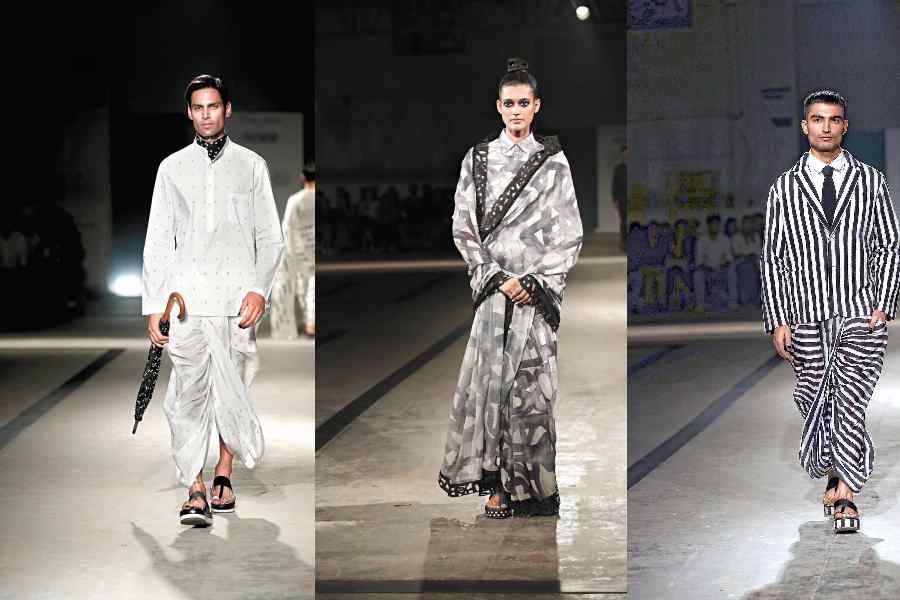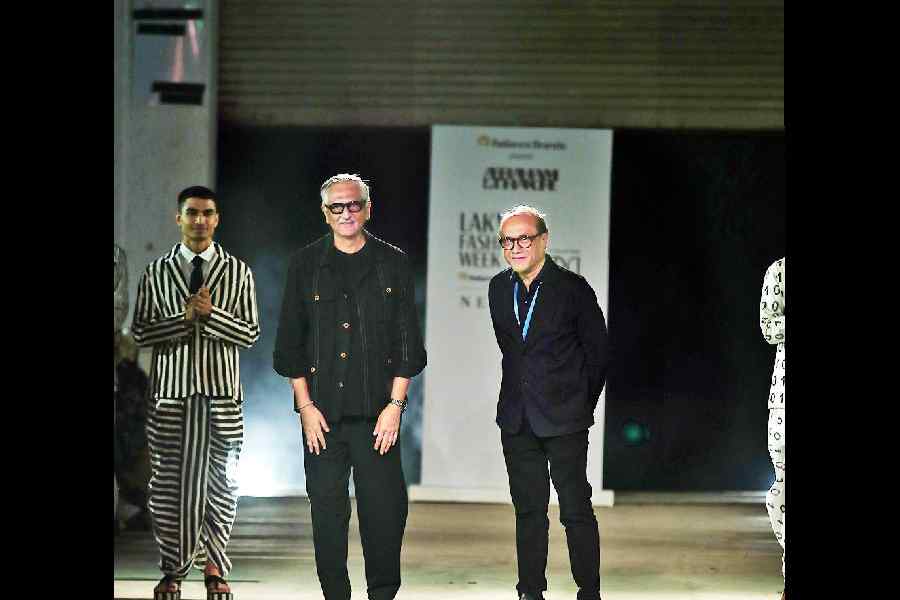Clarity of expression and the charm of an international cool with strong Indian roots. David Abraham & Rakesh Thakore are pioneers in that. Their Sustainable Fashion Day showcase ‘’Body Language’ at Lakme Fashion Week in partnership with FDCI, held at Pragati Maidan in Delhi, was a play of the minimal and the monochrome, a tale of the classic modern that has defined the brand over three decades.

Crisp relevance was at the core with the designer duo reinventing their expressions but never altering the DNA. Simplicity of emotions. And its several layers. A laser-cutwork sari worn with a bow tie and a shirt. A white shirt accessorised with a tie and layered with a white jacket with bold black plackets and a dhoti. A striped dhoti worn with a formal shirt and striped blazer. Men with black nail paint and women with white. Prints that created a sense of illusion. Complementary accessories. Topknots. Chunky sandals. Red lips. Easy and comfortable separates, some with a hint of sheer for a night of memories. All brought alive with ikat, ajrakh, brocade, badla and sequins. Our favourites were the dhotis. Eternally stylish.
The models walked inside a giant square. There was no limiting the soaring spirit of the duo though. #MenAtWork
David Abraham decoded the collection for t2.
The theme is an intriguing one...
It’s an exploration of fashion as a means of communication... it is about investigating how fashion or clothing helps people communicate with each other, but at a tangent. We have looked at as many methods of communication as we could and we have used many of them to develop a kind of basic design language, so the patterns, prints and embroideries are based on calligraphy, alphabet or Braille or Morse code. It gave us a direction for pattern generation, meaning motifs, but it is actually also a comment on how fashion is about communication. How we use clothes to define ourselves and to communicate to other people who we are in a social group and very small digression into clothing and gender, like what you associate with men’s clothes and what you associate with women’s clothes. They are all in a sense artificial constructs. So, we are just playing with that idea.
Fashion has always been about communication...

Rakesh Thakore and David Abraham
Fashion has always been about communication, wittingly or unwittingly, whether you think about it or are unaware, every decision is a way of signalling who you are and at every level of society. If we look at traditionally in India, we even had certain textiles worn by certain communities, and certain colours worn by certain religious groups. We have always signalled who we are through the attire we wear.
What is fashion communicating today?
If you are looking at an urban demographic and a demographic like a big city like Delhi or Bombay, one of the most important things people are signalling is status, education, now religion, in some cases caste... it’s so complex and multi-layered. Sometimes it is difficult to read, but if you are within the same group, you can read it. Sometimes when you are outside the group, you can’t read what people are trying to say, it’s not as easy. When I look at my friends... I know by the handbag they are carrying or the clothes they choose to wear, what their values would be. Some of them may not be true... (but) it tells you helluva lot. It’s much larger than fashion.

If you look at the most primitive communities in the world, they use markings and they paint their bodies and they tattoo... you may be quite naked, but you’ll have the most extraordinary jewellery. It’s visual and it’s the first thing you see.
Across the years, what has fashion communicated in general on how we are living?
It’s very different from community to community, from neighbourhood to neighbourhood and from city to city because now I think it’s all driven by industry, commerce, marketing. Having said that, advertisers create products we want to buy because they know what we are dreaming about because if they don’t, we are not going to buy. So, it’s a very complicated dialogue. It’s getting much more commercialised and moving much faster.
What do you make of the clone culture we are living in now? Everybody looks the same...
The word ‘clone’ makes me think of imitation... that’s very important and happens in all communities. People want to belong. Nobody wants to stand out. Whether it’s a tattoo or a marking on your body or even a bindi on your forehead, you actually want to look like everybody else. Within that, we also have to signal that we are slightly different. It’s very subtle language and defined.
